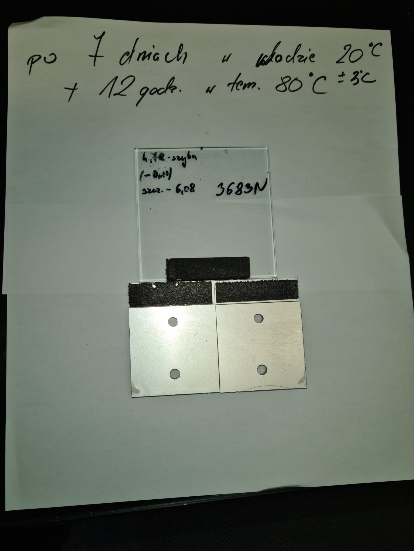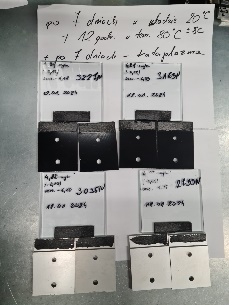Update 06/2023
During planning to change the technology of gluing car side window holders, we decided that the tests carried out should be adapted from the standards for PU adhesives used in existing technologies.
We considered these standards as the basis.
When we started developing the new ZAMPU technology, we had tapes that achieved peel strength in the PEEL test acc to ASTM-D3330 (more about the test: https://www.instron.com/en/testing-solutions/astm-standards/astm-d3330 ) from 20 to 25 N.
The next development in breaking strength for the new products we have come across is a jump to 40-45 N. In 2022-23, Walta was selected to test a new product, and we were amazed when we were informed that this new double-sided adhesive tape achieves a peel strength of 140 N in the PEEL test! We started shear testing (not peel testing) according to our requirements, unfortunately it turned out that our tear testing device, although capable of testing up to 5000 Newtons, achieved this value. 😊
After carrying out the tests presented earlier, we decided to test according to: ISO21194 standard and Annex A, called the cataplasm test. Positive test results not only confirmed the possibility of using double-sided adhesive tapes, they also helped us achieve better parameters. Below is a description of the test performed:
The test consists of 4 consecutive stages. After each stage, the breaking force is measured and its effect is assessed.
1) Gluing glass elements to the holders and measuring the breaking force after 24 hours of hardening at ambient temperature on randomly selected samples from each type of connection.
2) Storing the glued sets in DEMI water at room temperature for 7 days, and then, after 2-hour seasoning at ambient temperature, randomly selected samples from each type of connection, we measured the breaking strength.
3) We subjected the remaining samples to annealing at a temperature of 80º C, and then, after 2-hour seasoning at ambient temperature, randomly selected samples from each type of connection were measured, we measured the breaking force.
4) The remaining samples were heated for 7 days at a temperature of 70º C in saturated humidity (the so-called cataplasm method), and then, after 2-hour seasoning at ambient temperature of the rest of the test connections, we performed measurements of the breaking force. (The cataplasm test is performed by wrapping the tested items in cotton fabric, places it in tight foil bags with the addition of DEMI water, which continuously moistens the fabric and heats it for 7 days at a temperature of 70 ± 3º C.)

Samples after 7 days in water +20°C
and 12h in +80°C ± 3°C

Samples after 7 days in water +20°C
and 12h in +80°C ± 3°C
and 7 days of cataplasm test
Update 06/2023
As a template for the tests, we adopted the standards on the basis of which we conducted preparations for the shearing tests. The standards are as following:
The climatic conditions to which the samples were subjected lasted from 7 to 10 days and the temperature shock ranged from minus 40°C to plus 80°C and humidity 80%.
The tests were carried out on the side windows of cars as well as on glass intended for general purposes. The materials glued to the glass are:
The basic size of the adhesive tape is 15 mm x 60 mm
Shearing tests were carried out before and after aging.
The results range was: from 1100N to over 4000N.
In some cases (a primering), no breakage occurred and our breaking device reached max. load capacity 5300 N.
We conducted external tests after climatic cycles, on a large side window where a glued long element is a part of structure that holds the glass without guiding frames. The testing machine reached max. load of 8000 N, and no rupture occurred.
Before the breaks, we subjected the samples to fatigue test, as well as mounted the windows in the car doors, and so: